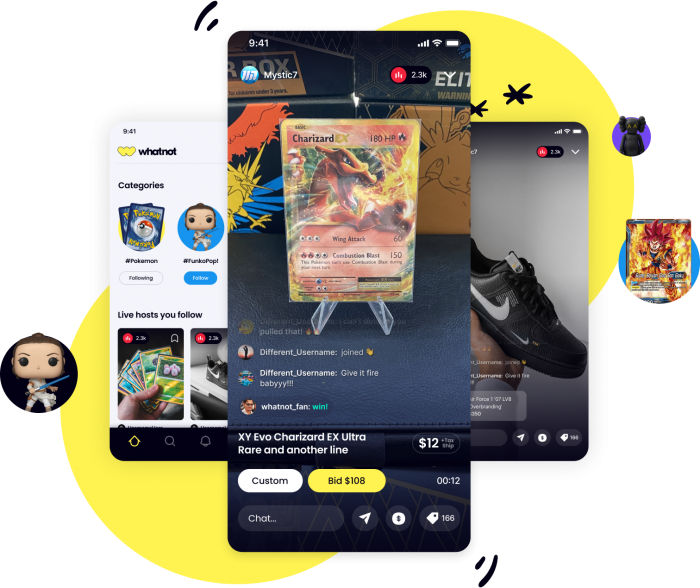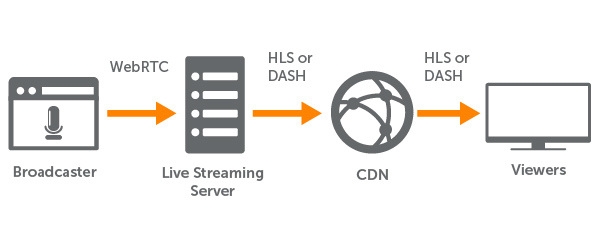WebRTC Use Cases for Professional Streaming

If you’re wondering what Web Real-Time Communication (WebRTC) can be used for, the answer is in its name. Let’s break it down:
- The web part of WebRTC means that the technology supports web applications by working directly within major browsers without any plugin.
- Real-time communication refers to WebRTC’s ability to power near-instantaneous video and data transfer via sub-500 second streaming.
Click-to-start video chats are the most common application for WebRTC. The framework already powers two-way communication on Slack, Google Hangouts, Facebook Messenger, and Houseparty. But what about when video calls go beyond just social networking?
From shoppable video to corporate communications, WebRTC is being used across a growing list of industries and applications. Here’s our list of the top ten use cases for real-time streaming in 2021.
10 WebRTC Use Cases
- Auctions
- Gambling and Betting
- Telehealth and Remote Monitoring
- Emergency Response and Communication
- Connected Fitness and Health
- Live Commerce and Shoppable Video
- Gaming and Esports
- Online Education
- Live Sports
- Corporate Communications
Auctions
Real-time streaming is bringing 18th-century auction houses and rural livestock markets to the global digital world. Even Gen Z shopping platforms like Whatnot are getting in on the action, using the bidding format to increase participation and drive up sales prices.

Regardless of whether an auction is centered around automobiles or fine art, any broadcast delays can translate to billions of dollars in lost revenue. How? A 30-second lag might prevent bids from being recorded properly or result in a lower final sales price.
Luckily, sub-500-millisecond streaming delivered via WebRTC eliminates problematic delays and ensures that everyone has the same opportunity to place their bids.
Gambling and Betting
Horse races, casinos, and sportsbooks have all gone virtual. Hopping on a plane to Las Vegas isn’t always possible, but live streaming brings online betting to every corner of the globe.
Twitch now boasts ~150 slot machine gambling channels. Likewise, sports betting apps such as FanDuel and BetMGM have seen extraordinary growth in the U.S. due to recent legislation.
Part of the excitement of gambling comes down to the fast pace and reciprocal nature. Real-time delivery is key, allowing online participants to participate in a time-synchronized experience.
For these reasons and more, there’s simply no room for lag. WebRTC has helped online gambling operators overcome any challenges with latency and is a critical technology for many interactive betting applications.
Telehealth and Remote Monitoring
Video-enabled telehealth is now instrumental for everything from virtual doctor visits to camera-aided surgical technologies, with WebRTC hard at work in the background for many telemedicine services.
Video calls between patients and doctors are self-explanatory. In these use cases, WebRTC combines the lowest latency possible with an accessible end-user experience via browser-based streaming. But IoT medical providers like Child Health Imprints are also using WebRTC for device-to-person communications. Specifically, their cloud-hosted appliance enables remote doctors to monitor babies on life support across the globe by streaming low-latency video with Wowza Streaming Engine. In these types of WebRTC-powered medical IoT systems, doctors are able to track patient vitals such as blood pressure, body temperature, and the like. Watch the video below to learn more.
Emergency Response and Communication
In a similar vein to telehealth, emergency communications technologies leverage WebRTC for mission-critical data exchange. Bodycams, video-enabled 911 calls, and disaster relief robots all rely on video streaming for information sharing. Any lag could mean the difference between life and death for these applications, making real-time streaming critical.
As one example, the emergency 911 service Carbyne relies on a hybrid WebRTC workflow to achieve both real-time interactivity and scale. The platform leverages Wowza’s WebRTC capabilities to support sub-500 millisecond video delivery from virtually any connected device. This supports two-way video chat between citizens and call-takers. From there, Wowza Streaming Engine repackages the feed into the HLS protocol for broad distribution to paramedics, law enforcement officers, hospitals, and other stakeholders.
Connected Fitness and Health
In addition to medical-grade monitoring, WebRTC streaming now powers wearable health devices, consumer baby monitors, and connected fitness equipment like the Mirror. Even exercise activity trackers like Fitbit have added video streaming capabilities to their devices, allowing wearers to monitor their movement and stream workouts via the same gadget.
For surveillance devices like baby monitors, real-time video streaming often involves ingesting an RTSP video source and repackaging the stream as WebRTC. This allows developers to easily restream an IP camera feed with sub-second delivery. Peloton’s bikes were also built by embedding WebRTC into their equipment, which allows users to start live video chats with their friends during classes.
Live Commerce and Shoppable Video
Interactive shopping fueled by live video reigns supreme in Asian markets, with adoption now spreading across the globe. Dubbed live commerce, this convergence of video and shopping helps improve engagement and drive sales.
Online marketplaces, live events, and influencer streaming applications can all leverage real-time shoppable video to get in on this trend. Successful virtual shopping environments all deliver on interactivity, making WebRTC a go-to enabling technology.
Gaming and Esports
Timing is everything for gamers. And with today’s platforms centered around audience participation, streamers require a continuous feedback loop to act on comments and suggestions from viewers.
When it comes to gaming and esports, slow-paced video delivery can ruin the fun. What’s more, developers continue to transform the industry by adding new layers of interactivity. From virtual reality to multiplayer gaming, WebRTC helps ensure the real-time streaming needed for a dynamic, action-packed experience.
Online Education
Remote learning takes the form of both collaborative video chats and one-to-many lectures. The right WebRTC workflow can power any number of tele-education applications by providing instant access to video content within browsers. A key challenge in distance learning is accessibility — so developers would be wise to integrate WebRTC as a means to democratize education, build more immersive experiences, and remove any barriers to entry.
One Wowza customer, DocTutorials, streams interactive live medical lectures to audiences of varying sizes. Low-latency streaming is critical to the back-and-forth nature of their workflow, but scalability is also a concern. By leveraging the Real-Time Streaming at Scale feature in Wowza Streaming Cloud, they overcame these challenges.
“With Wowza, we’re now able to offer interactive video with less than a second of latency, allowing end users to chat and interact in real time — regardless of whether 500 or 1,000 viewers are watching.”
— Karteek Routh, Director of Operations and Product Development, DocTutorials
Live Sports
When it comes to live sports, it’s like we always say: Nobody wants to learn the final score on their Twitter feed while the broadcast they’re watching lags behind. Because mobile apps, websites, and television screens all compete for our attention, broadcasters must deliver as real time of an experience as possible to engage viewers.
Many of us consume live events across multiple screens. Whether at the stadium or at home, our experience is often supplemented by the jumbotron, our smartphones, or even “watch party” features within a streaming platform.
WebRTC streaming levels up the fan experience by ensuring real-time delivery and supporting new forms of interactivity. What’s more, broadcasters can now leverage Real-Time Streaming at Scale from Wowza to take advantage of encoder-based streaming and/or RTMP ingest, while ensuring sub-second video delivery.
Corporate Communication
Whether enterprise communication takes the form of a marketing webinar or an all-hands meeting, WebRTC proves useful for browser-based streaming at scale. Presenters can easily publish their video streams directly from the browser with just a webcam and microphone (often built into their computer). Then, once the content reaches a media server, it can be distributed through a custom WebRTC content delivery network (CDN) to preserve real-time delivery or repackaged into a more scalable format like HLS.


Conclusion
Wherever real-time audio and video deliver value, WebRTC makes it happen. But the technology wasn’t designed to support one-to-many or broadcast-quality streaming capabilities out of the box. Luckily, though, Wowza offers multiple options for transmuxing and scaling the format to accommodate different workflows.
When it comes to sub-second streaming to large audiences, our Real-Time Streaming at Scale feature in Wowza Streaming Cloud checks all the boxes. Developers can configure interactive streaming environments by combining real-time delivery with two-way functionality. Content distributors can even use a professional encoder for production-quality broadcasts. Simply transport the RTMP-encoded stream to Wowza Streaming Cloud, where it’ll be repackaged into WebRTC for sub-second delivery.
For whatever you’re trying to build, Wowza delivers the technology and expertise required to shape the future of streaming. It’s simple: If you can dream it, Wowza can stream it.




